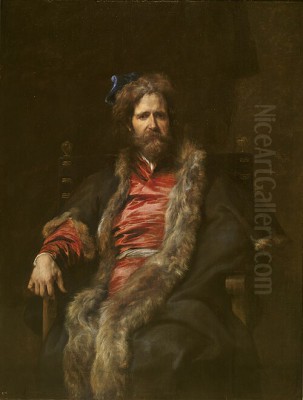
Marten Ryckaert stands as a notable figure in the rich tapestry of Flemish Baroque art. Active during the late sixteenth and early seventeenth centuries, he carved a niche for himself primarily as a landscape painter, contributing significantly to the genre's development in Antwerp. His life and career are particularly remarkable considering the physical challenge he overcame, solidifying his legacy not just through his art but also through his personal resilience. Born into an artistic dynasty, Ryckaert navigated the vibrant Antwerp art scene, leaving behind a body of work admired for its distinctive style and technical skill.
His story begins in Antwerp in 1587. He was part of a family deeply rooted in the city's artistic traditions. His father was David Ryckaert the Elder (also known as David Ryckaert I), a painter and art dealer working with beer jugs and wooden statues, who likely provided Marten's initial instruction in art. The Ryckaert name would continue its association with painting through Marten's nephew, David Ryckaert III, who gained fame for his genre scenes later in the seventeenth century. This familial connection placed Marten within an established network from the outset of his career.
Early Life and Artistic Formation
Marten Ryckaert's life was marked from birth by a significant physical challenge: he was born without his left arm or with a malformed one. This congenital condition could easily have precluded a career in the demanding field of painting. However, Ryckaert demonstrated exceptional determination. His physical limitation did not hinder his ambition or his ability to achieve a high level of artistic proficiency, a testament to his dedication and innate talent. This fact became a defining part of his identity within the Antwerp artistic community.
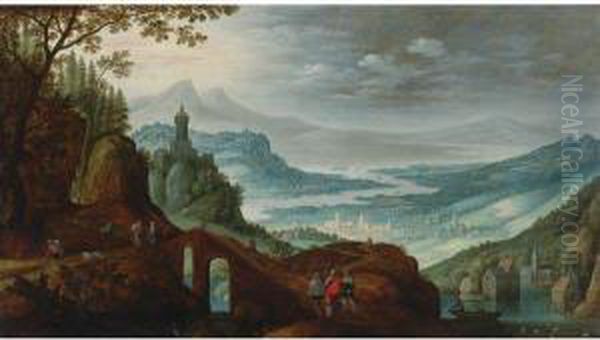
Following his initial training, likely under his father David Ryckaert I, Marten sought further instruction to hone his skills, particularly in landscape painting. He became a pupil of Tobias Verhaecht, a respected Antwerp artist specializing in landscapes, often fantastical mountain scenes. Verhaecht was a significant figure, known not only for his own work but also for being one of the early teachers of the towering figure of Flemish Baroque art, Peter Paul Rubens. Studying under Verhaecht placed Ryckaert in esteemed company and provided him with a solid foundation in landscape composition and technique.
The Question of Italy and Guild Membership
A recurring theme in discussions of Marten Ryckaert's work is its pronounced Italianate character. His landscapes often feature rocky outcrops, classical ruins, waterfalls, and a warm, clear light reminiscent of the Italian Campagna. This stylistic affinity has led to speculation that Ryckaert traveled to Italy, perhaps sometime between 1605 and 1610, to study firsthand the landscapes and art that clearly inspired him. Such trips were common for ambitious Northern European artists seeking to broaden their horizons and absorb classical and Renaissance influences.
However, despite the strong stylistic evidence, there is no definitive documentary proof confirming Ryckaert's journey south of the Alps. His Italianate manner might also be explained by the widespread influence of Italian and Italian-inspired art within Antwerp itself. Works by artists like Paul Bril, a Flemish painter who spent most of his career in Rome and whose landscapes were highly influential and widely disseminated through prints and imported paintings, were well-known in the North. Ryckaert could have absorbed the Italianate style through exposure to such works in his native city, without ever having traveled to Italy himself. The question remains open to interpretation by art historians.
Regardless of whether he traveled abroad, Ryckaert established himself professionally in Antwerp. A key milestone was his acceptance into the prestigious Antwerp Guild of Saint Luke in 1611. This membership formally recognized him as an independent master painter. Notably, the Guild records reportedly list him as 'de schilder met één arm' – the painter with one arm. This acknowledgment underscores how his physical condition was a known aspect of his persona, yet clearly no barrier to his acceptance and recognition within the professional artists' organization.
Artistic Style and Influences
Marten Ryckaert specialized almost exclusively in landscape painting, often on a relatively small scale. His works typically depict imaginary, often mountainous or rocky, scenes rather than topographically accurate views. Waterfalls, winding rivers, rustic cottages, ancient ruins, and small figures populate these vistas. His style is characterized by a meticulous attention to detail, particularly in the rendering of foliage, which often features delicate, feathery brushwork and carefully placed highlights that create a sense of texture and vibrancy.
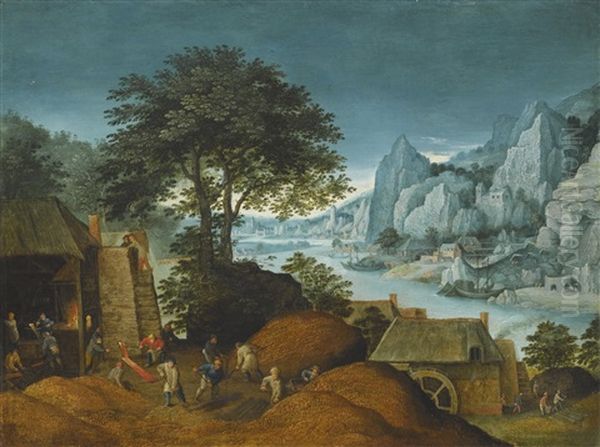
The influence of his teacher, Tobias Verhaecht, can be seen in the sometimes fantastical or dramatic nature of his mountain landscapes. However, Ryckaert developed a more refined and less rugged style than Verhaecht. The strongest stylistic connection is often made with the aforementioned Paul Bril, whose idealized Italian landscapes, balancing naturalistic detail with harmonious composition, seem to resonate strongly in Ryckaert's work. He adapted these influences into a personal style, marked by clarity, careful composition, and often a serene or idyllic mood, even when depicting wild terrain.
While firmly rooted in the Flemish landscape tradition that stretched back to pioneers like Joachim Patinir and Herri met de Bles, Ryckaert's work represents a specific branch focused on Italianate scenery. This contrasts with some of his Antwerp contemporaries, such as Jan Brueghel the Elder, known for his detailed 'paradise' landscapes and flower paintings, or later landscape specialists who focused more on local Flemish scenery. Ryckaert carved out his own distinct niche within this diverse artistic environment. The influence of Pieter Bruegel the Elder's compositional structures for landscape can also be detected in some of Ryckaert's arrangements, showing a lineage connecting back to the great master of sixteenth-century Flemish art.
Notable Works and Themes
Several works exemplify Marten Ryckaert's style and thematic interests. One frequently cited painting is The Road to Emmaus. This work takes a biblical subject – the resurrected Christ appearing to two disciples – and sets it within a characteristic Ryckaert landscape. The figures are often small, dominated by the expansive, detailed natural setting, a common feature in his work where the landscape itself is the primary subject. The composition likely draws on established traditions for depicting this scene, possibly showing an awareness of designs by earlier masters like Pieter Bruegel the Elder.
Another significant aspect of his oeuvre is his depiction of industrial scenes, particularly ironworks or foundries, often set within dramatic Alpine landscapes. Paintings like Alpine Landscape with Iron Foundry are fascinating not only for their artistic merit but also as historical documents, offering glimpses into early modern industrial activity. These works demonstrate Ryckaert's versatility and his interest in incorporating contemporary elements into his idealized landscapes. They stand out for their unusual subject matter within the landscape genre of the period.
Beyond these specific examples, his body of work consistently features rocky landscapes with waterfalls, ruins, castles, and small figures often engaged in pastoral or travel activities. Some sources also suggest he may have occasionally painted religious subjects beyond landscape settings, and perhaps even still lifes, although he is overwhelmingly known for his landscapes. His paintings were clearly popular, finding a ready market among Antwerp collectors.
Overcoming Disability and Professional Success
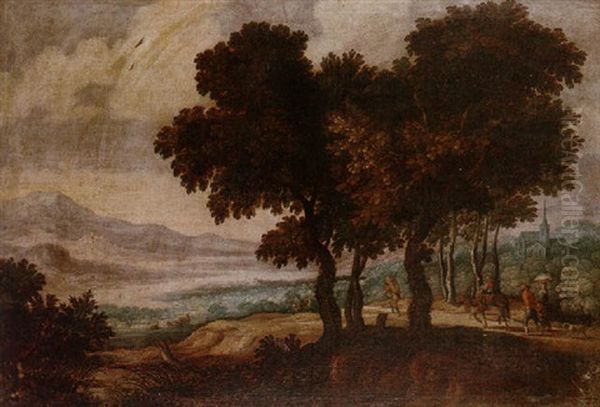
The fact that Marten Ryckaert achieved considerable success as a painter despite having only one arm is a remarkable aspect of his biography. The physical act of painting – grinding pigments, preparing panels or canvases, handling brushes with precision – would have presented unique challenges. Historical sources do not detail his specific working methods, but his accomplished technique speaks volumes about his adaptability and skill. He was known to be a productive artist, suggesting he developed efficient ways to manage the demands of his craft.
His standing in the Antwerp art world is further confirmed by his friendship with Anthony van Dyck, one of the leading portrait painters of the era and a fellow Antwerp native. Van Dyck included Ryckaert in his Iconography, a series of portrait prints and drawings depicting famous contemporaries. Van Dyck's sensitive portrait drawing of Ryckaert (later etched by Jacob Neefs) survives, showing the artist in thoughtful repose. This inclusion alongside princes, scholars, and fellow renowned artists indicates the high regard in which Ryckaert was held.
His paintings commanded respectable prices in the Antwerp art market. While historical currency conversions are complex, records suggesting prices ranging from around 3 to 30 guilders (or pounds, depending on the source interpretation) place his works within the reach of middle-class collectors, indicating a solid market demand for his specialized landscapes. He maintained a successful career until his death in Antwerp on October 11, 1631.
Legacy and Influence
Marten Ryckaert's primary contribution to art history lies in his role as a specialist landscape painter who successfully integrated Italianate aesthetics into the Flemish tradition. He helped popularize this style of idealized, often mountainous or ruin-filled landscape in the Low Countries. His meticulous technique and harmonious compositions found favour with collectors and likely influenced other artists working in Antwerp.
His most direct artistic legacy continued through his family. His nephew, David Ryckaert III (1612-1661), became a successful painter. While David III initially painted in a style somewhat influenced by Adriaen Brouwer, focusing on peasant genre scenes, taverns, and rustic interiors, the family connection provided him with an entry into the artistic world Marten inhabited. Marten's success likely provided a foundation and inspiration for his nephew's own career.
Within the broader context of Antwerp painting, Ryckaert was a respected specialist contemporary to giants like Rubens and Van Dyck, and specialists in other fields like the animal painter Frans Snyders or the still life artist Osias Beert the Elder. While perhaps not as revolutionary as Rubens, Ryckaert played a significant role in the diversification and richness of Antwerp's artistic output during the seventeenth century, particularly within the landscape genre.
Art Historical Context and Lack of Controversy
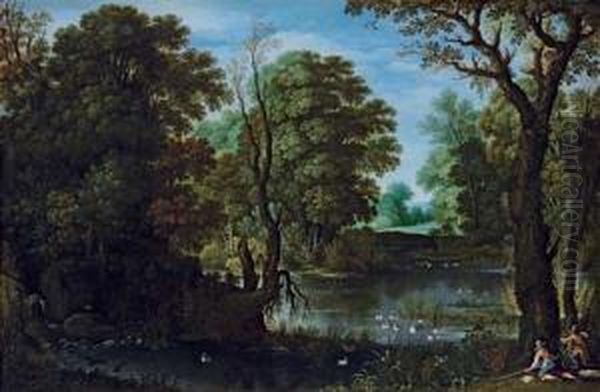
Marten Ryckaert worked during the vibrant Baroque period, a time of great artistic innovation across Europe. His specialization in Italianate landscapes placed him within a specific but popular trend in Northern European art. His work offers a Northern interpretation of the classical landscapes associated with Rome and its surroundings, filtered through Flemish sensibilities regarding detail and finish.
Interestingly, while the history of art is replete with controversial figures and artworks that challenged societal norms or artistic conventions – from the revolutionary compositions of Michelangelo to the provocative realism of Edouard Manet, the conceptual challenges of Marcel Duchamp's Fountain, or the debated subject matter of painters like Walter Sickert or Hans Makart – Marten Ryckaert does not appear to have been a figure of significant controversy. Available historical sources and art criticism do not highlight major disputes surrounding his work's subject matter, style, or reception. His career seems to have been one of steady professional achievement and respect within his field. Artists like Jan Matejko faced criticism for historical interpretations, while Max Beckmann's work drew fire for its perceived pessimism, but Ryckaert's landscapes seem to have been generally well-received as skillful and aesthetically pleasing contributions to the genre.
Conclusion
Marten Ryckaert emerges from the annals of art history as a talented and dedicated Flemish landscape painter. His specialization in Italianate scenes, rendered with meticulous detail and atmospheric sensitivity, secured him a place within the Antwerp school. Perhaps most inspiring is his triumph over a significant physical disability, demonstrating remarkable perseverance to become a respected master in the Guild of Saint Luke and a friend to luminaries like Anthony van Dyck. While the question of his potential travels to Italy remains unresolved, the Italian spirit infused in his work is undeniable. He remains known as the "one-armed painter" of Antwerp, a unique figure whose art continues to be appreciated for its charm, skill, and contribution to the rich tradition of Baroque landscape painting.